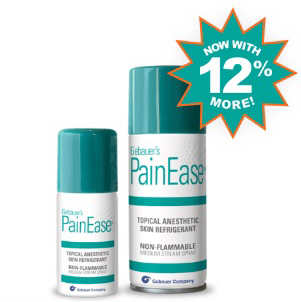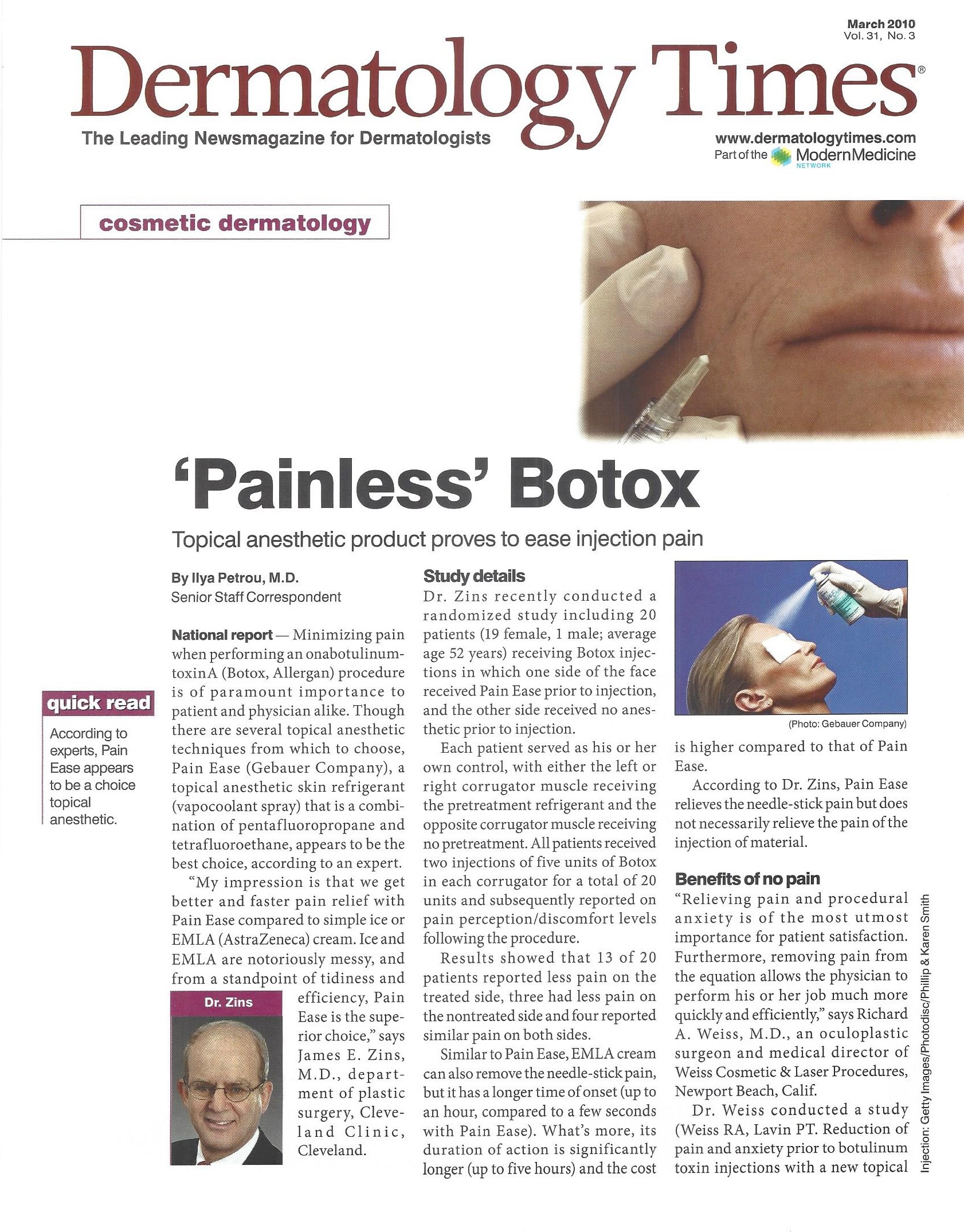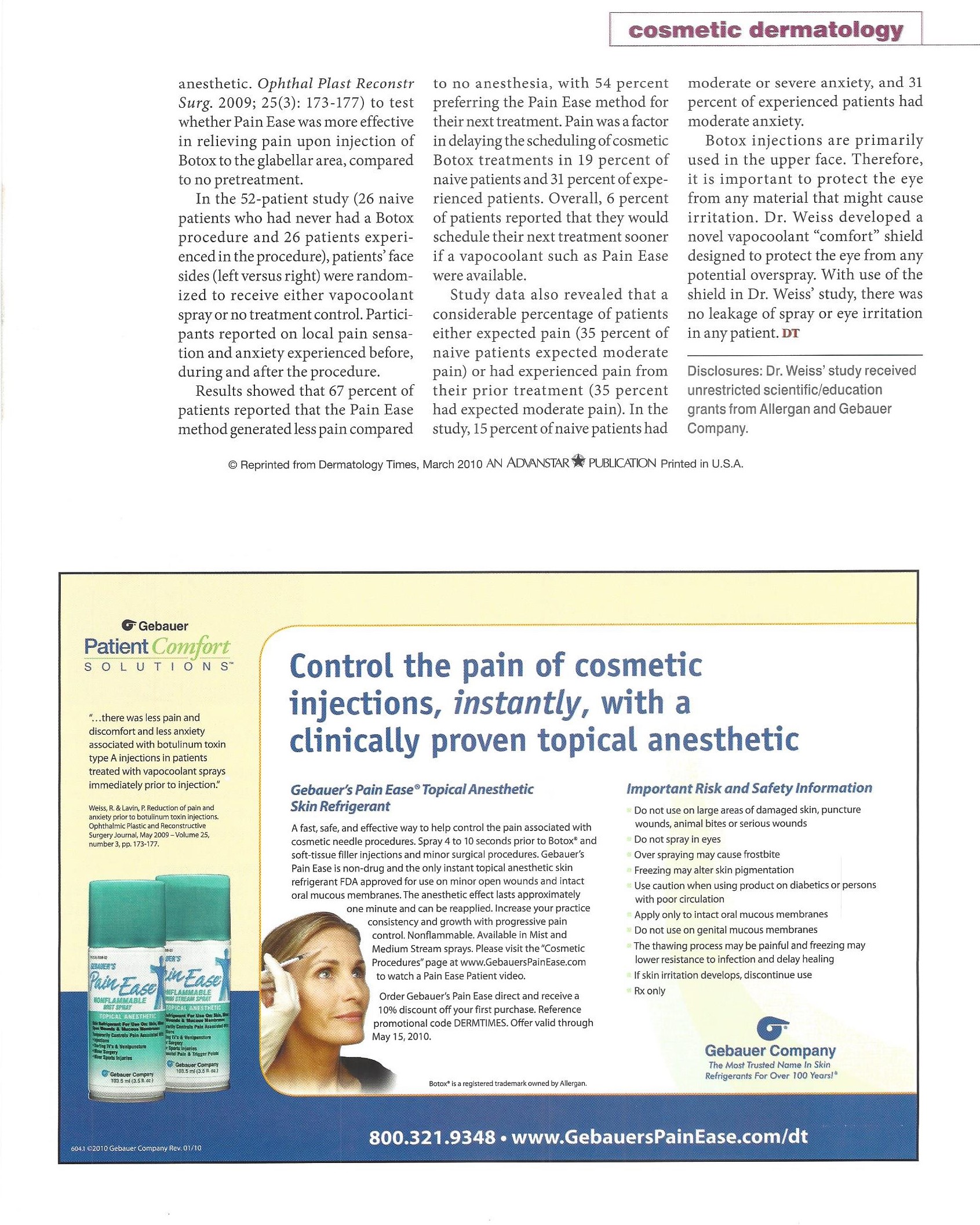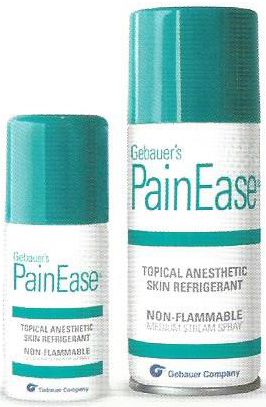Products
Pain Ease
PAIN EASE The INSTANT topical Anesthetic
Gebauer's Pain Ease is a topical anesthetic skin refrigerant (vapocoolant) that begins working in just 4-10 seconds. Pain Ease is FDA-cleared to temporarily control the pain associated with needle procedures and minor surgical procedures.

ADDITIONAL PAIN EASE BENEFITS
- Pain Ease can be sued prior to, or in some cases in place of, lidocaine injections.
- Non-drug
- Non-flammable
- Easy to use
- Can be used by any licensed healthcare practitioner without the order of a physician
PAIN EASE PRODUCT DETAILS
Gebauer's Pain Ease topial spray is available in several variations to provide medical professionals with a choice of delivery for instant patient comfort.
- Pain Ease 3.9 fl. oz. in Medium Stream P/N 0386-0008-03
- Pain Ease 1.0 fl. oz. in Medium Stream P/N 0396-0008-04
- Pain Ease 3.9 fl. oz. in Mist P/N 0386-0008-02
- Pain Ease 1.0 fl. oz. in Mist P/N 0386-0008-01
Minor Surgical Procedures
Gebauer's Pain Ease is intended for topical application on intact skin, minor open wounds, and intact oral mucous membranes to temporarily control pain associated with:
- Immunizations
- IV starts
- Joint injections
- Blood draws
- Incision and drainage of small abscesses
- Foreign body removal
- Lancing boils
- Skin tag removal
- Suturing and suture removal


Pain Ease Does Not Cause Vasoconstriction
Clinical evidence supports that Gebauer's Pain Ease topical anesthetic skin refrigerant does not cause vasoconstriction.
"Nurses rated the technical ease of the [IV] attempt as 'easy or 'very easy' more often when the vapocoolant spray was used then when placebo was used.."
"Cannulation on first attempt was more often successful with the use of vapocoolant spray (85.0%) than with placebo (62.5%)"
We did not anticipate the improved cannulation success rate...because we expected that vasoconstriction might make cannulation more difficult.
Farion K, Splinter K, Newhook K, Gaboury I, Splinter W. The effect of vapocoolant spray on pain due to intravenous cannulation in children: a randomized controlled trial. Canadian Medical Association Journal, July 1, 2008; 179 (1), pp 31-6.
"It causes less interference with cannulation than lidocaine; even though it freezes the skin, no venoconstriction occurs and, unlike lidocaine, no tissue distortion occurs."
Armstrong P, Young C, McKeown D. Ethyl chloride and venepuncture pain: a comparison with intradermal lidocaine. Can J Anaesth. 1990 Sep; 37(6): 656-8.
"The characteristics of the PIV itself were similar between the two gruops (placebo spray and Pain Ease spray) with no significant differences in ... PIV successs rate, number of PIV attempts, difficulty of PIV..."
Mace, Sharon E. Prospective, double blind, randomized, controlled trial comparing vapocoolant spray versus placebo spray in adults undergoing intravenous cannulation. Scandinavian Journal of Pain, October 2017. Volume 17, 8 - 15
"Despite nureses' concerns regarding vasoconstriction, IV insertion success rates were above average, and most IVs were easily placed."
"76% of subjects who had received Pain Ease thought that it worked 'well'...patients who had received Pain Ease (90%) would want that treatment again..."
Waterhouse MR, Liu DR, Wang VJ. Cryotherapeutic topical analgesics for pediatric intravenous catheter placement: Ice versus vapocoolant spray. Pediatr Emerg Care. 2013 Jan; 29(1):8-12. doi: 10.1087/PEC.0b013e31827b214b.
"Pain Ease cools skin to well below freezing... Temperature changes at SubQ (-5.9℃) and IM (-1.4℃) are small, short lived and may not be clinically meaningful."
Cold Perception, Surface, Subcutaneous and Intramuscular Temperatures Produced by Gebauer's Pain Ease Topical Vapocoolant Spray. Merrick MA, Martin KM. Journal of Athletic Training, 47(3), Supplement, 91; May 2012.

Pain Ease benefits include:
- Temporarily controls pain and anxiety in as few as 4 to 10 seconds
- Use on intact skin, minor open wounds and intact oral mucous membranes
- May be used by any licensed healthcare practitioner without the order of a physician
- Non-drug, non-flammable formula

Pain Ease is Safe for AQseptic Procedures
Gebauer's Pain Ease topical anesthetic skin refrigerant has passed microbial examinations of non-sterile products and is safe to be used prior to aseptic procedures.
Pain Ease will not introduce or add microorganisms to a site that has already been cleansed with an antiseptic.
"The vapocoolant (Pain Ease) 1,1,1,3,3 pentalfluoropropane and 1,1,1,2-tetrafluoroethane is sprayed on skin prepared with povidone-iodine; there is no statistically significant increase in bacterial colonization."
Schleicher WF, Richards BG, Huettner F, Ozturk C, Zuccaro P, Zins JE, Skin sterility after application of a vapocoolant spray. Dermatol Surg. 2014 Oct; 40(10): 1103-7. doi: 10. 1087/01.DSS.0000452654.29636.56.
- The proprietary blend of Hydro fluorocarbons (HFC's) uesd in Pain Ease are FDA cleared skin refrigerants and filtered to screen out particulates larger than 0.2 microns.
- Pain Ease is filled in a controlled environment which undergoes microbial monitoring during each manufacturing run.
- The air in the manufacturing particulates to levels established for a Class 100,000 clean room.
- Assessment of the air, sufaces and personnel are based on the recommendations specified in the United States Pharmacopeia (USP) General Chapter <1116>, Microbial Evaluations of Clean rooms and Other Controlled Environ ments.
- Lots of Pain Ease are tested to USP <61> and USP <62> by an ouside, independent laboratory. These tests determine the total aerobic microbial count (TAMC) and total yeast and mold counts (TYMC) present. They also demonstrate that a substance is free from Staphylococcus aureus (staph) and Pseudonmonas aeuginosa.
- Lots of Pain Ease are not released until testing is completed and all microbiological results meet acceptance criteria.
Over 10 years +
50 million applications =
A lot of happy patients
Important Risk and Safety Information for Gebauer's Pain Ease:
Consult your pediatrician when using on children 4 years old and younger. Do not use on large areas of damaged skin, puncture wounds, animal bites or serious wounds. Do not spray in eyes. Over spraying may cause frostbite. Freezing may alter skin pigmentation. Use caution when using product on persons with poor circulation. Apply only to intact oral mucous membranes. Do not use on genital mucous membranes. The thawing process may be painful and freezing may lower resistance to infection and delay healing. If skin irritation develops, discontinue use. CAUTION: Federal loaw restricts this device to sale by or no ther order of a licensed healthcare practitioner.